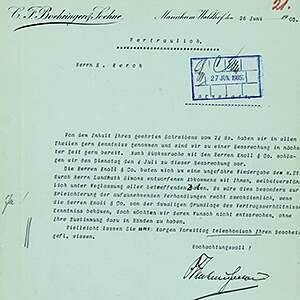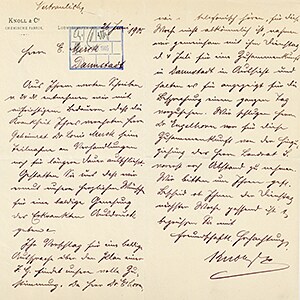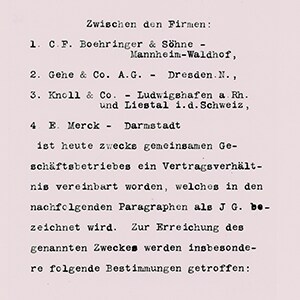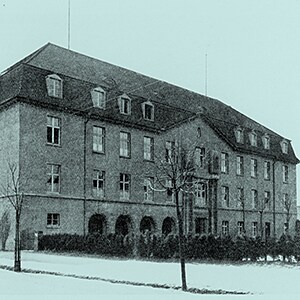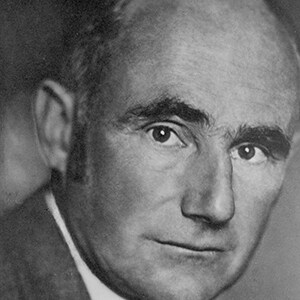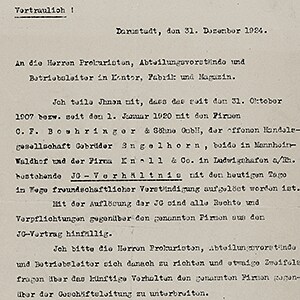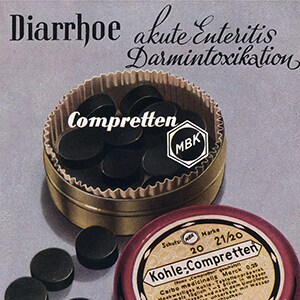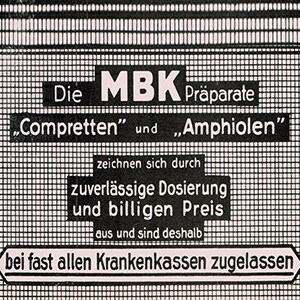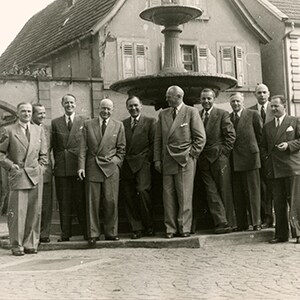
»Work on joint account, in line with uniform guidelines to the furthest possible extent, yet while respecting the individual characteristics of each company.«
The basic principle of the company with respect to the community of interests, 1906
In 1906, the companies E. Merck, Darmstadt, Germany, Boehringer and Knoll, which had already enjoyed friendly relations for some time, and the company Gehe join forces to form acommunity of interests, to which the company Riedel is added in 1907. There is an urgent need to create a counterweight to the ever-increasing number of tar dye factories, which for their part have come together in two blocks since 1904: Bayer, BASF and Agfa as well as Hoechst, Cassella and Kalle.
Such collaborations, which also involve price fixing, are not prohibited. Cost reductions are expected by exchanging experience and patents, avoiding duplicate research and coordinating production ranges. Otherwise, the individual companies retain their independence, but profits are distributed according to a certain key.
Defined as a »community of interests among businesses«, the Interessengemeinschaft streamlines the product range by concentrating the manufacture of certain pharmaceutical products in individual companies. E. Merck, Darmstadt, Germany, for example, gives up the production of codeine in favor of Knoll, yet produces alkaloids such as atropine or scopolamine for the other companies. The savings, already in the more cost-effective procurement of raw materials in large quantities, are considerable.
Of course, there is always some friction, for example when setting production and profit targets or implementing uniform accounting guidelines. In the economically difficult 1920s, however, the diverging interests become stronger, the tone of correspondence sharper and sharper – a rupture occurs.
However, E. Merck, Darmstadt, Germany, Boehringer and Knoll see another basis for cooperation. The market for ready-to-use »specialities« is dominated by foreign pharmaceutical products, above all French ampoules and English »tabloids«, to which doctors are becoming more and more accustomed, as these are easier to prescribe than the traditional formulations from pharmacopoeias. When, at the beginning of World War I, imports cease abruptly and the demand for German products becomes strong, they jointly offer a range of important tablets and ampoules under the trademark »MBK« and legally protect the names »Compretten« and »Amphiolen«. The first price list is published in 1915.
The commitment brings the desired success: Physicians »welcome the pharmaceutical products right from the start and continue to do so to this very day«, as noted with satisfaction on the 25th anniversary of MBK. The community of interests exists until 1971 – in this year, pharmaceutical products and trademarks are transferred to Cascan, an E. Merck, Darmstadt, Germany, subsidiary.
The firm Gehe – an important customer of E. Merck, Darmstadt – is soon included in the negotiations that begin in 1904 between Boehringer, E. Merck and Knoll. After months of exchanging letters and documents, which clearly reveal the parties’ different notions, a four-member community of interests agreement is signed in 1906.
Karl Merck conducts the negotiations with the partners on behalf of the Darmstadt-based company. In the 1920s, the diverging interests become even stronger within the complex structure, which can only be coordinated with a great deal of effort and mutual trust. In 1924, the companies dissolve the community of interests »in amicable agreement«.
Pharmaceutical products are launched under the trademark »MBK« and remain highly popular even after the community of interests no longer exists. »Kohle-Compretten« (charcoal tablets) can be found in every household medicine cabinet. Clever advertising finds favor not only with patients, but also company representatives, depicted here during a meeting in 1953.

